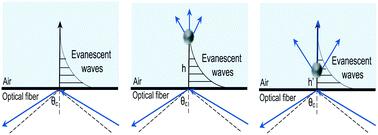当前位置:
X-MOL 学术
›
Environ. Sci.: Nano
›
论文详情
Our official English website, www.x-mol.net, welcomes your
feedback! (Note: you will need to create a separate account there.)
Evanescent wave interactions with nanoparticles on optical fiber modulate side emission of germicidal ultraviolet light
Environmental Science: Nano ( IF 5.8 ) Pub Date : 2021-08-16 , DOI: 10.1039/d1en00199j Zhe Zhao 1 , Mariana Lanzarini-Lopes 1 , Emma Westerhoff 2 , Xiangxing Long 1, 3 , Hojung Rho 1, 4 , Yuqiang Bi 1 , Li Ling 5 , Paul Westerhoff 1
Environmental Science: Nano ( IF 5.8 ) Pub Date : 2021-08-16 , DOI: 10.1039/d1en00199j Zhe Zhao 1 , Mariana Lanzarini-Lopes 1 , Emma Westerhoff 2 , Xiangxing Long 1, 3 , Hojung Rho 1, 4 , Yuqiang Bi 1 , Li Ling 5 , Paul Westerhoff 1
Affiliation

|
Silica nanoparticle coating on quartz optical fiber facilitates side-emission of germicidal ultraviolet light (UV-C), which shows promise for disinfection of contaminated air, water, and surfaces. However, the emitted light along the length of optical fibers decreases exponentially with distance from the LED light source, which makes designing applications more challenging and reduces overall useable length of optical fiber to disinfect water or surfaces. This work aims to develop an understanding of light interactions with the silica nanoparticles to allow more uniform side-emission of germicidal light along longer lengths of optical fibers. Two forms of light energy (refracted light and evanescent waves) are transmitted through optical fibers. The amount of side-emitted UV-C light is overwhelmingly controlled by the evanescent wave energy interacting with nanoparticles at distances from <2 to 100 nm from the surface of the optical fiber. Varying the separation distance enables up to ten-fold (10×) modulation in intensity of side-emitted UV-C light, demonstrated 1) experimentally through ionic-strength modifications during a manufacturing process, and 2) through first-principle models. These insights enabled fabrication of side-emitting optical fibers (SEOFs) with more uniform light emission along their entire length (>30 cm). The fundamental insights and experimental validation into light interactions with nanoparticles on SEOF surfaces, in conjunction with prior bacterial inactivation studies, enables use of UV-C light produced by light emitting diodes (LEDs) to mitigate biofilm formation on confined surfaces commonly found in water treatment, premise plumbing, and cooling systems.
中文翻译:

消逝波与光纤上纳米粒子的相互作用调节杀菌紫外线的侧发射
石英光纤上的二氧化硅纳米粒子涂层可促进杀菌紫外线 (UV-C) 的侧面发射,这显示出对受污染空气、水和表面进行消毒的前景。然而,沿光纤长度发射的光随着与 LED 光源的距离呈指数下降,这使得设计应用更具挑战性,并减少了光纤用于水或表面消毒的总可用长度。这项工作旨在了解光与二氧化硅纳米粒子的相互作用,以允许沿更长的光纤更均匀地侧发射杀菌光。两种形式的光能(折射光和渐逝波)通过光纤传输。侧面发射的 UV-C 光的数量主要由与距离光纤表面 <2 到 100 nm 的纳米粒子相互作用的倏逝波能量控制。改变分离距离可以使侧向发射的 UV-C 光的强度调制多达十倍 (10x),证明 1) 通过制造过程中的离子强度修改进行实验,以及 2) 通过第一原理模型。这些见解使得能够制造沿其整个长度(> 30 cm)具有更均匀光发射的侧发光光纤(SEOF)。结合先前的细菌灭活研究,对 SEOF 表面上与纳米粒子的光相互作用的基本见解和实验验证,
更新日期:2021-08-20
中文翻译:

消逝波与光纤上纳米粒子的相互作用调节杀菌紫外线的侧发射
石英光纤上的二氧化硅纳米粒子涂层可促进杀菌紫外线 (UV-C) 的侧面发射,这显示出对受污染空气、水和表面进行消毒的前景。然而,沿光纤长度发射的光随着与 LED 光源的距离呈指数下降,这使得设计应用更具挑战性,并减少了光纤用于水或表面消毒的总可用长度。这项工作旨在了解光与二氧化硅纳米粒子的相互作用,以允许沿更长的光纤更均匀地侧发射杀菌光。两种形式的光能(折射光和渐逝波)通过光纤传输。侧面发射的 UV-C 光的数量主要由与距离光纤表面 <2 到 100 nm 的纳米粒子相互作用的倏逝波能量控制。改变分离距离可以使侧向发射的 UV-C 光的强度调制多达十倍 (10x),证明 1) 通过制造过程中的离子强度修改进行实验,以及 2) 通过第一原理模型。这些见解使得能够制造沿其整个长度(> 30 cm)具有更均匀光发射的侧发光光纤(SEOF)。结合先前的细菌灭活研究,对 SEOF 表面上与纳米粒子的光相互作用的基本见解和实验验证,











































 京公网安备 11010802027423号
京公网安备 11010802027423号